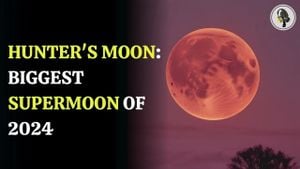Intensified fighting is erupting once again on the fronts of the Russia-Ukraine war, particularly around the strategic Kursk Oblast. This region holds significant importance, as both Ukrainian and Russian forces battle for control over it, with stakes now heightened by developments involving the United States. Following Donald Trump’s recent presidential election victory, the Kremlin is eager to reclaim territory before any peace negotiations might begin, viewing Kursk as pivotal for future discussions.
Ukrainian forces have managed to hold much of their recent territorial gains, which had brought them to the forefront of international attention just months prior. Back during the summer, Ukraine's military made significant incursions, capturing approximately 200 square miles of land within the Kursk region, which the Russian military claimed. But following Ukraine’s initial success, Russia launched relentless counterattacks, gradually regaining about half of the territory they had lost.
U.S. intelligence reports suggest Vladimir Putin's forces are now deploying additional troops to mount this counteroffensive, including estimates of up to 10,000 North Korean soldiers. This aggressive push triggered alarm bells as Ukraine and its allies brace for what might come next, knowing Trump’s administration could alter the dynamics of military aid and support.
According to analysts, the Kremlin’s strategy is clear: they want to secure control of Kursk before any potential peace talks emerge. A high-ranking Kremlin insider indicated the Russian goal is to ``kick out every last Ukrainian soldier from Kursk`` to avoid the territory being used as leverage for negotiation. This approach is also rooted deeply within Putin's narrative, which tends to frame territorial control as indicative of strength and security, especially when entering talks for peace.
The rhetoric around negotiations is increasingly fraught, particularly with the Russian Foreign Minister Sergei Lavrov rejecting calls to establish frozen front lines akin to those agreed upon during the 2014 Minsk Agreements. Analysts speculate Ukraine might face increasing pressure to yield land as Russian forces continue their three-pronged assault.
Ukrainian President Volodymyr Zelenskyy recently gave insight during a radio interview, expressing worries over the potential stalling of peace talks, especially as Russian troops continue to advance. He noted, “From our side, we must do everything so this war ends next year, ends through diplomatic means.” Despite this, Zelenskyy echoed his long-standing position against any peace terms without the full withdrawal of Russian forces, which included Russia’s continued hostile actions against Ukraine.
The conflict has taken severe tolls on both sides, with recent reports indicating Ukrainian forces have successfully countered many of the Russian assaults. Reports from Ukraine's military reveal they recently destroyed over 50 Russian military vehicles, including armored personnel carriers and tanks, even as they fend off continuous attacks. Remarkably, Ukrainian intelligence officers note the Russian troops' repeated tactical blunders, such as missteps on roads monitored by Ukrainian forces.
This information is corroborated by other accounts coming from within the region, intensifying the struggle between Ukrainian tenacity and Russian ambition. Despite the chaos on the Russian side, the pressure remains serious, as Russian military units launch well over twenty attacks daily against positions held by Ukrainian troops, particularly along the frontline territories.
Embedded within these military engagements is also the story of how global politics is reshaping the battlefield. Reports indicate Trump's election has emboldened the Kremlin, leading them to believe they may gain some leverage when it eventually suits the U.S. to negotiate. Washington's current stance on Ukraine is under heavy scrutiny, as fears rise concerning the future direction of U.S. assistance.
While President Zelenskyy’s administration prepares for what may be next amid this newfound uncertainty, they are also facing internal challenges, including questions surrounding troop morale and effective governance under the strain of continued military pressure.
This complex web of military maneuvers continues both within the constraints of territorial battles and the broader political theater playing out on the world stage.
Yet as both sides dig their heels, the question remains: will this renewed fighting lead to any strategic advantage for Russia, or will Ukraine’s resilience hold firm against the tumultuous tide of conflict? With each passing day, the fate of Kursk Oblast appears intricately tied to the ebb and flow of power both on the ground and within the political machinations of nations at play.
The Russian drive to reclaim their territory, amid the crunch of battle, suggests how deeply the course of negotiations relies on military outcomes. Analysts continue to watch closely, gauging when the next round of talks may take place and what conditions might lead to lasting truce.



